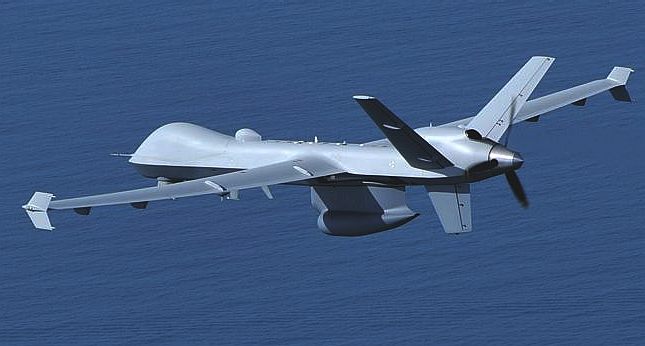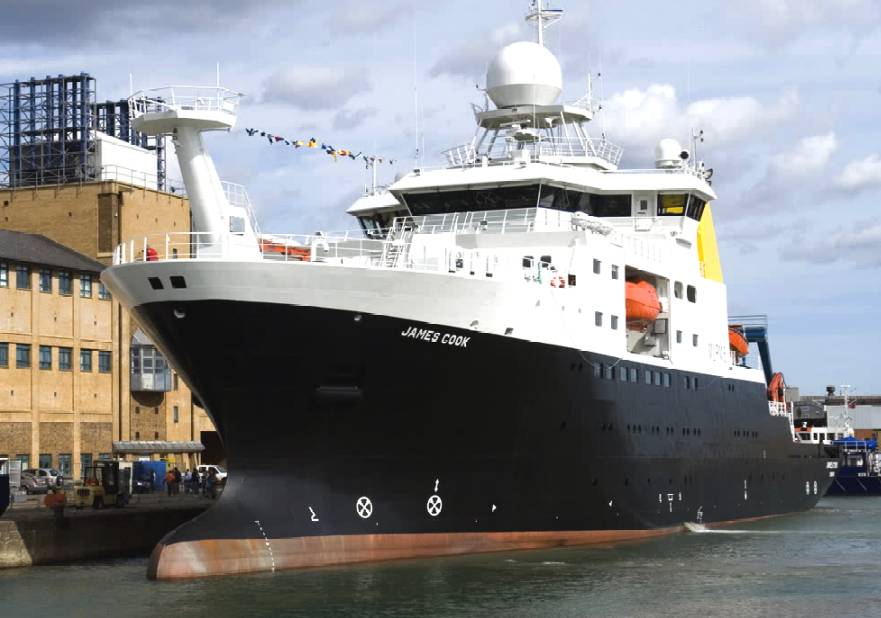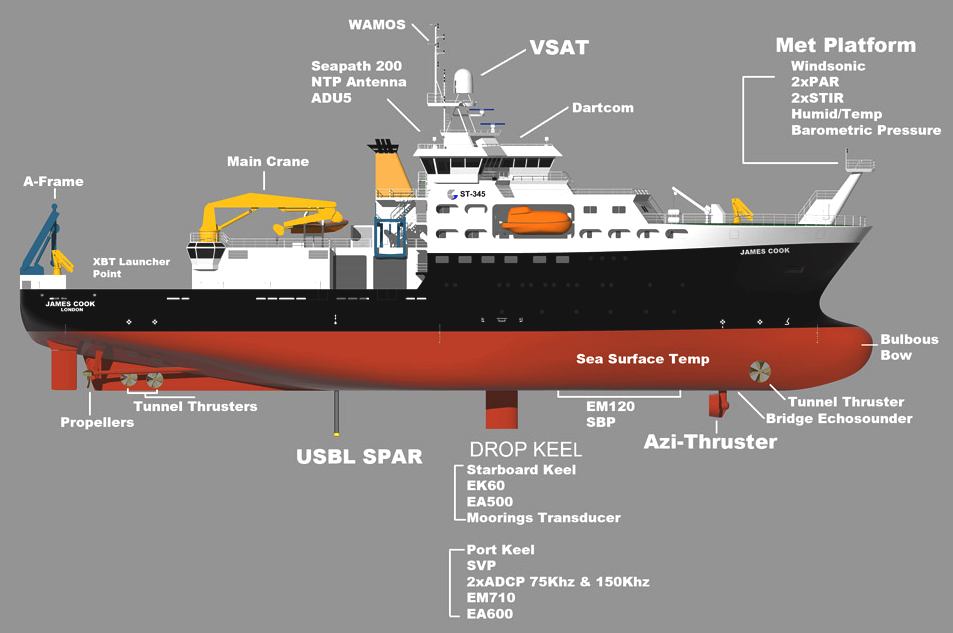
UK
and USA COLLABORATE ON UNMANNED SURVEY - 25 January 2013
In the first scientific collaboration of its kind, British and American scientists are trading skills and expertise and are using an unmanned robotic aircraft to gather high altitude atmospheric data.
Today (Friday 25 January) NASA is holding an event at its Dryden Flight Research Center in Southern California to showcase a number of Earth science missions to study climate change and air pollution.
One of the NASA campaigns, the Airborne Tropical Tropopause Experiment (ATTREX), has a sister campaign just starting in the UK - the Natural Environment Research Council (NERC) Coordinated Airborne Studies in the Tropics (CAST) project.
NASA's Global Hawk. Copyright NASA Photo / Lori Losey.
The aircraft, a NASA Global Hawk, originally developed for military missions, will explore the tropical tropopause layer, the region where the Earth's air enters the stratosphere. This region is where pollutants and greenhouse gases are transported into and out of the atmosphere and can potentially influence our climate.
The scientists will be studying these chemical and climate interactions, and will aim to discover how much of the gas moves up into storms, something we have very little knowledge of at present.
The science teams will programme the Global Hawk to fly into the most climate-sensitive and difficult to reach regions close to the equator, at an altitude of around 20km (approx. 65,600 feet) above the Earth - around twice the cruising height of a commercial passenger jet.
UK lead scientist Dr Neil Harris from the University of Cambridge said, "We are the first UK group to work with NASA using the Global Hawk as a science platform. The project will be very efficient in terms of sharing equipment, expertise and data, and we expect the results to answer some fundamental questions about how the movement of atmospheric pollutants can influence the Earth's climate."
As part of the project, two new instruments and software are currently being developed by researchers at several of the partner institutes, and will be fitted into the Global Hawk.
One of these is GHOST (GreenHouse Observations of the Stratosphere & Troposphere), a short-wave infra-red spectrometer designed to measure greenhouse gas concentrations and the way they are transported through the atmosphere to and from the Earth's surface.
It is being designed and developed at the Science & Technology Facilities Council (STFC) UK Astronomy Technology Centre in Edinburgh, and is a joint effort with the Universities of Leicester and Edinburgh.
Dr Hartmut Boesch from the University of Leicester, who is leading the GHOST project, said, "The CAST project offers us a unique opportunity to develop an instrument using UK technology, that will address key questions about the transport of greenhouse gases and provide a critical link to satellite observations."
Over the next 12 months the research teams will be getting ready for the first CAST-ATTREX high altitude flights with the Global Hawk over the Pacific Ocean and South East Asia, which are planned for January or February 2014.
The high altitude flights will be complemented by lower-level flying from the NERC/Met Office BAe-146 Atmospheric Research Aircraft, which is managed by the Facility for Airborne Atmospheric Measurements (FAAM).
The FAAM BAe-146 in flight
Dr Harris said, "The coordinated use of both aircraft to investigate the very big storms present in this region of the Pacific at the start of the year will be scientifically ideal for the CAST project."
The FAAM aircraft will begin its research mission from Guam in the Pacific Ocean and land on the island of Chuuk for refuelling before flying to the equator and back. The Global Hawk has the advantage of being able to remain airborne for up to 30 hours, and can travel 20,000 km - a distance equivalent to half the Earth's circumference.
NERC Press Office
Natural Environment Research Council
Polaris House, North Star Avenue
Swindon, SN2 1EU
Tel: 01793 411727 or 411561
Mob: 07917 086369 or 557215
Jake Gilmore
STFC Press Office
Tel: 01793 442092
Fred Lewsey
University of Cambridge Press Office
Tel: 01223 765566
Ather Mirza
University of Leicester Press Office
Tel: 0116 252 3335
NERC
HISTORY
The National The Natural Environment Research Council (NERC) is a British research council that supports research, training and knowledge transfer activities in the environmental sciences.
NERC began in 1965 when several environmental (mainly geographic) research organisations (including Nature Conservancy which became the Nature Conservancy Council in 1973 and was divided up in 1991) were brought under the one umbrella organisation. When most research councils were re-organised in 1994, it had new responsibilities - Earth observation and science-developed archaeology. Collaboration between research councils increased in 2002 when Research Councils UK was formed.
Chief executives
Sir John Lawton 1999-2005
Professor Alan Thorpe 2005-2011
Dr Steven Wilson (Acting) - 2011-2012
Professor Duncan Wingham - from 1st January 2012(BIS announcement)
Organisational structure
The council's head office is at Polaris House in Swindon, alongside the other six Research Councils. NERC's research centres provide leadership to the UK environmental science community and play significant and influential roles in international science collaborations.
Mission
The Natural Environment Research Council delivers independent research, survey, training and knowledge transfer in the environmental sciences, to advance knowledge of planet Earth as a complex, interacting system. The council's work covers the full range of atmospheric, Earth, biological, terrestrial and aquatic sciences, from the deep oceans to the upper atmosphere, and from the geographical poles to the equator.
NERC's mission is to gather and apply knowledge, create understanding and predict the behaviour of the natural environment and its resources, and communicate all aspects of the council's work. The British Meteorological Office is not part of NERC.
Airborne Research and Survey Facility
The NERC Airborne Research and Survey Facility (ARSF) collects and processes remotely sensed data for use by the scientific community. The data are collected by various instruments on-board a Dornier 228 research aircraft based in Gloucester, UK. These instruments currently include a Leica LIDAR and two hyperspectral sensors, Eagle and Hawk. Meteorological data are also collected in-flight.
Processing is performed by ARSF-DAN (Data Analysis Node) at Plymouth Marine Laboratory.
Formation 1965 - Non-Departmental Government Body
Purpose/focus Funding of UK environmental science research
HQ Polaris House
Location North Star Avenue,
Swindon,SN2 1EU
Tel: 01793 411500
Fax: 01793 411501
PRESS OFFICERS
Marion O'Sullivan
Tel: 01793 411727
Mob: 07917 086 369
Tamera Jones
Tel: 01793 411561
Mob: 07917 557 215
Region served United Kingdom
Chief Executive Prof. Duncan Wingham
Chairman Mr. Edmund Wallis
Parent organization: Department for Business, Innovation and Skills
Research Councils UK
Affiliations AHRC, BBSRC, EPSRC, ESRC, MRC, RCUK, STFC, TSB, UKSA
Budget £400 million
Website: www.nerc.ac.uk

RSS DISCOVERY
Ship Type: Research (converted cargo) vessel
Year Built: 1962
Length x Breadth: 90 m X 14 m
DeadWeight: 1520 t
Speed recorded (Max / Average): 10.4 / 9.5 knots
Flag: United Kingdom [UK]
Call Sign: GLNE
IMO: 5090660, MMSI: 233882000

RSS JAMES COOK
FEBRUARY 2007
Royal Research Ship James Cook was commissioned by the Natural Environment Research Council. She was designed by norwegian ship designer, Skipsteknisk AS, and constructed in Norway. However, the hull was built in Poland. In 2006 she was registered in London, with her official christening by
HRH Princess Royal at the National Oceanography Centre, Southampton, in Feburary 2007. Costing £36million she is the newest British research vessel. In March 2007 she embarked on her maiden science voyage to the Mid Atlantic Ridge to study the fifteen-twenty fracture zone (FTFZ) which consisted of core drilling and sample collection from 16,000ft below the sea surface.
James Cook is a specially designed research vessel and has a variety of laboratories, store rooms, fridges & freezers, workshops and deck space especially for this reason. The laboratories are 'bare bone' so with every new science voyage all the equipment is installed for the duration. This allows a whole variety of research to be undertaken including biology, physics, chemistry, geology, geochemistry and the operation of remotely operated vehicles
(ROVs).
HRH The Princess Royal formally named the UK's new
royal research ship RRS James Cook in a ceremony held earlier this month at the National Oceanography Centre (NOC) in Southampton.
The latest addition to the National Environment Research Council's (NERC) fleet of oceanographic research ships is managed by the NERC's National Marine Facilities Division, which is based at the NOC. The ship is operated by professional mariners who provide a working platform and practical assistance to the scientists on board.
The new ship will carry scientists to some of the earth's most challenging environments, from tropical oceans to the edge of the
ice sheets. It has been designed as a multi-disciplinary scientific platform enabling investigations using precisely targeted instruments such as deep sea ROVs. It can accommodate large scientific parties and is highly flexible in the use of deck and laboratory space.
The ship was built by Norwegian yard Flekkefjord Slipp & Maskinfabrikk AS to a design developed by compatriots at Skipsteknisk AS. Since its delivery on time and within budget last August, RRS James Cook has undergone a programme of extensive sea trials to confirm its performance and safety at sea.
The ship sails on its first official voyage early next month to the Mid Atlantic Ridge, a massive underwater mountain range, where DP technology will keep it stationary whilst instruments are deployed to capture information about how the Earth's crust is formed.
Commenting at the ceremony, NERC chief executive Professor Alan Thorpe said, 'With oceans covering around three quarters of the Earth, ships like these are vital for the research community. They can reach places that would otherwise be impossible to explore. They allow us to discover micro-organisms that could, for example, be used to develop new antibiotics. And they help us to monitor and understand changes in the oceans that affect temperature and climate.'

Displacement: 4500tonnes
Length: 89.20m
Bredth: 18.60m
Max Draft: 6.20m
Engine: Diesel-Electric
Max Powwer: 7080kW
Officers: 11
Crew & Technicians: 12
Scientists: 31
CONTACTS
National
Environment Research Council
LINKS
http://noc.ac.uk/

The
SolarNavigator - SWASSH (Small Waterplane Area Stabilized Single Hull)
test model 2012. The
latest Solarnavigator is designed to be capable of an autonomous
endurance for surveying and patrol work. A demonstration world navigation set for
2015 if development proceeds according to schedule.




